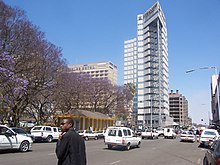Economy of Zimbabwe

|
|
| Currency | US Dollar, South African Rand, Botswana Pula, Pound Sterling, Australian Dollar, Renminbi, Indian Rupee, Euro and Japanese Yen |
|---|---|
| calendar year | |
|
Trade organisations
|
WTO |
| Statistics | |
| GDP | $14 billion |
| GDP rank | Nominal: 123rd / PPP: 126th |
|
GDP growth
|
1.8% (2013 est.) [6] |
|
GDP per capita
|
$600 (2012 est.) |
|
GDP by sector
|
Agriculture: 20.3%, industry: 25.1%, services: 54.6% (2012 est.) |
| 0.65% (2016 est.) | |
|
Population below poverty line
|
80% |
| 56.8 | |
|
Labour force
|
5.634 million (2014 est.) |
|
Labour force by occupation
|
Agriculture: 60%, Services: 9%, Wholesale, Retail, Hotels, Restaurants: ~4%, Manufacturing: 4%, Mining: 3% (2003) |
| Unemployment |
Disputed 11% to 94% (2008) |
|
Main industries
|
mining (coal, gold, platinum, copper, nickel, tin, clay, numerous metallic and non-metallic ores), steel; wood products, cement, chemicals, fertilizer, clothing and footwear, foodstuffs, beverages |
| 161st (2017) | |
| External | |
| Exports | $3.263 billion (2014 est.) |
|
Export goods
|
platinum, cotton, tobacco, gold, ferroalloys, textiles/clothing |
|
Main export partners
|
|
| Imports | $5.135 billion (2014 est.) |
|
Import goods
|
machinery and transport equipment, other manufactures, chemicals, fuels, food products |
|
Main import partners
|
|
| Public finances | |
| Domestic: $1 billion (Dec 2010), International: $10.57 billion (2014 WB), $5.3 billion (March 2010), USD $1.3 billion (Dec 2002) |
|
| Revenues | $2.876 billion (2016) |
| Expenses | $3.840 billion (2016) |
| Economic aid | recipient: $178 million; note - the EU and the US provide food aid on humanitarian grounds (2000 est.) |
The economy of Zimbabwe shrank significantly after 2000, resulting in a desperate situation for the country – widespread poverty and a 95% unemployment rate. Zimbabwe's participation from 1998 to 2002 in the war in the Democratic Republic of the Congo set the stage for this deterioration by draining the country of hundreds of millions of dollars.Hyperinflation in Zimbabwe was a major problem from about 2003 to April 2009, when the country suspended its own currency. Zimbabwe faced 231 million percent peak hyperinflation in 2008. A combination of the abandonment of the Zimbabwe dollar and a government of national unity in 2009 resulted in a period of positive economic growth for the first time in a decade.
The country has reserves of metallurgical-grade chromite. Other commercial mineral deposits include coal, asbestos, copper, nickel, gold, platinum and iron ore.
Since 2000, Zimbabwe has seized and forcibly redistributed most of the country's white owned commercial farms. The new occupants, which included black only citizens and several prominent members of the ruling ZANU-PF administration, were usually inept, inexperienced, or uninterested in farming – thereby failing to retain the labour-intensive, highly efficient management of previous landowners. Short term gains were achieved by selling the land or equipment. The contemporary lack of agricultural expertise has triggered severe export losses and negatively affected market confidence. Idle land is now being utilised by rural communities practicing subsistence farming. Production of staple foodstuffs, such as maize, has recovered accordingly – unlike typical export crops including tobacco and coffee. Zimbabwe has also sustained the 30th occurrence of recorded hyperinflation in world history.
Government spending is 29.7% of GDP. State enterprises are strongly subsidized, taxes and tariffs are high. State regulation is costly to companies, starting or closing a business is slow and costly. Labour market is highly regulated, hiring a worker is cumbersome and firing a worker is difficult. By 2008 unemployment had risen to 94%.
A 2014 report by the Africa Progress Panel has found that of all the African countries looked at when working out how many years it would take to double per capita GDP, Zimbabwe fared the worst and that at its current rate of development it would take 190 years for the country to double its per capita GDP. Uncertainty around the indigenisation programme, the perceived lack of a free press, the possibility of abandoning the US dollar as official currency, and political uncertainty flowing the end of the government of national unity with the MDC as well as power struggles within ZANU-PF have increased concerns that the country’s economic situation could further deteriorate.
...
Wikipedia
